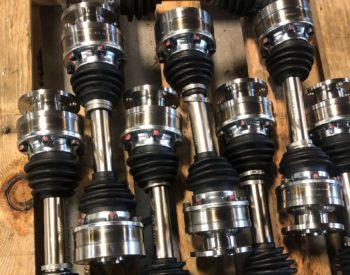DFM Advice for CNC Turned Prototype Models
If you rely on CNC machining services for your prototype models, you’re already familiar with both CNC milling and CNC turning.
These subtractive manufacturing methods are used to machine materials like aluminum, steel, and many thermoplastics. But the two processes are quite different, and they work best for different types of parts.
Generally speaking, milling is best for flat parts, such as control panels, and turning is optimal for cylindrical parts, such as threaded inserts. Some parts require both milling and turning to create all the necessary features.
Understanding the different capabilities of each CNC machining service can help you optimize your designs to reduce cost and lead time. Today, we’ll take a look at 5 Design for Manufacturing (DFM) tips for CNC turned parts.
Design for Manufacturing Tips for CNC Turned Prototype Models
Follow these best practices when designing parts for CNC turning:
1. Limit critical tolerances
Specialized tools, advanced fixturing, and long setup times are often necessary to meet tight tolerance requirements for CNC turned parts. These factors contribute to a part’s cost and lead time, so it’s best to limit critical tolerances when you can.
We’ve seen some clients call out an entire diameter along a shaft as a critical tolerance when in reality, only a small section of the diameter must meet this specification. Avoiding this type of misstep is an essential DFM best practice.
2. Try to accommodate a center
When the length of a CNC turned part exceeds 4x its diameter, the equipment is unable to support the part from one end of the lathe, and secondary support is required. The quickest, most cost-effective way to stabilize the part during turning is to accommodate a live center, a tool which adds support but leaves a small dimple on the end of the part. An exceptionally long part may also need a saddle center, which prevents cross-sliding.
If you can’t accommodate a center mark on your part, we can still turn it on our lathes. As an alternative, we’ll machine a turning taper (i.e., a gradual reduction in diameter from one end) to achieve true diameter throughout the part. Just keep in mind that this approach involves longer setup and cycle times, which can impact cost and lead time.
3. Limit non-round features
It’s possible to machine non-round milled features on a multi-axis lathe, but these operations require additional setups that can drive up the cost of a project.
If perpendicular features aren’t critical for your part’s fit, form, or function, consider limiting them to save money. We can use a simple 2-axis lathe to machine most round features quickly and cost-effectively.
4. Call out the intention of undercuts
Clarifying the intention of undercuts helps your manufacturing partner understand which ones are critical to part functionality.
For instance, an undercut designed for “thread relief” purposes is usually considered non-critical, while an undercut that serves as a “sealing groove” likely needs to hold a tighter tolerance.
Be sure to include these callouts on the drawing or in the feature descriptions, so there’s no room for confusion.
5. Specify fully threaded requirements
For some applications, the surfaces of mating parts must connect completely; in other cases, a small gap between mating surfaces is acceptable.
If you need mating parts to touch, let us know, and we’ll add thread relief to accommodate this need. However, keep in mind that this extra cut can affect cost and lead time. It could also potentially cause weakness in the part and even become a point of failure.
If we don’t make an additional cut for thread relief, you’ll have a small gap between the two mating surfaces. Not sure whether you need thread relief? We’re happy to help advise you.
We’re CNC turning experts here at KAD. With our state-of-the-art equipment, we can turn low-volume quantities of parts like hubs and shafts measuring up to 8” in diameter and 14” in length! Request a quote today.



